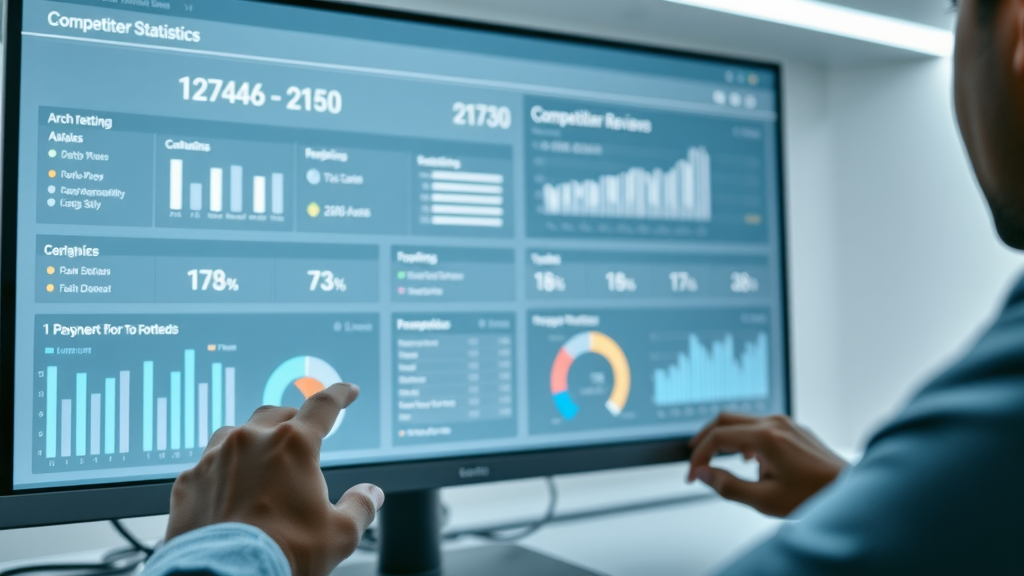Did you know that 72% of property services customers trust online reviews as much as personal recommendations? Imagine the edge you could gain if you could read all your local competitors’ reviews, services, and pricing—instantly. In today’s fast-paced, digital-first property services industry, understanding how to use AI to analyze your local competitors’ reviews could be the key to rising above your local pack and winning more customers. This guide unveils how artificial intelligence is making it possible—and why you can’t afford to be left behind.
Unveiling the Power of AI in Local Competitors' Reviews – A Startling Industry Shift
In recent years, the use of AI for analyzing local competitors' reviews has reshaped the competitive landscape for property service businesses. What once required hours of manual research can now be achieved in seconds—thanks to smart algorithms that can scan, organize, and interpret hundreds of online reviews, Google Business Profiles, and pricing data with razor-sharp accuracy.

"72% of property services customers trust online reviews as much as personal recommendations – are you gaining ground, or losing it?"
With customer review data now central to local SEO strategies, AI tools put actionable intelligence at your fingertips. You’ll see not just what your direct competitors are doing, but also how they’re perceived—good or bad—by their local customer base. This intelligence gives you a clear map to refine your own services, enhance your Google Business Profile, and stay ahead in the local search results.
What You'll Learn in This Guide to Local Competitors' Reviews
- How to use AI for analyzing local competitors' reviews and services
- Best practices for leveraging competitor analysis in local SEO strategy
- Actionable local SEO techniques using Google Business Profiles data
- Real-world applications for property services businesses
Understanding Local Competitors' Reviews in the Age of Local SEO
The modern property service business landscape is fiercely competitive, and local SEO is the new battleground. Customers are relying on online reviews more than ever—these reviews are often the first step in the decision-making process. Local competitors' reviews offer a treasure trove of data: what local customers value, which services beat expectations, and where your rivals are falling short. To thrive, you must not only satisfy your clientele but also analyze your local competitors with precision, learning from both their strengths and their weaknesses.

The Role of Local SEO and Local Search in Competitor Analysis
Local SEO and local search are critical for business owners aiming for prime real estate in the local pack and Google Maps. Effective competitor analysis starts with understanding which businesses appear alongside you in local search results and why. Search engines prioritize businesses with high-quality reviews, detailed and optimized Google Business Profiles, and positive customer feedback. By examining your local competitors' reviews, you see which services are celebrated, which pricing models attract the most loyalty, and which gaps exist in the marketplace. Armed with this knowledge, you can fine-tune your SEO strategy to make informed decisions that help your business rank higher and attract more local customers.
Why Local Competitors' Reviews Are Business-Critical
Reviews shape first impressions and directly influence consumer trust. A strong database of positive reviews can put a local business on the map—literally propelling it to the top of the local pack. Analyzing your local competitors’ reviews provides an unfiltered look into customer expectations and common pain points within your niche. Businesses that systematically leverage this insight—using AI to find patterns in customer sentiment and service feedback—can swiftly adjust their offerings, customer experience, and pricing to beat the competition. In essence, every review your competitor receives is a learning opportunity for your business to gain a strategic edge.
Step 1: Gathering and Structuring Local Competitors' Reviews Data
The first step to effective competitor analysis is gathering comprehensive data on local competitors' reviews and business profiles. Today’s AI-powered tools can extract information across platforms, such as Google Maps, Google Business Profiles, and other local review sites. With structured datasets, you can compare metrics like review counts, average ratings, service categories, and pricing ranges. Creating a well-organized database is the foundation for uncovering actionable insights that will drive your local SEO strategy forward.
Extracting Google Business Profile and Business Profiles Data
A well-crafted Google Business Profile is essential for visibility in local search. Using automated scraping tools or specialized AI, you can systematically gather public data from your local competitors’ Google Business Profiles: star ratings, core service offerings, top keywords, location data, and even customer Q&A. When you standardize and structure this information, you can easily identify which businesses dominate local search results and why. This extraction forms the basis for analysis—allowing you to benchmark your business against your competition based on real marketplace feedback.
Building a Database of Local Competitors and Customer Reviews
Once review and profile data is extracted, the next step is consolidating it into a review database. This should include: each competitor’s name, total review count, average rating, primary service categories, and price points. The more organized your data, the more powerful your insights will be. A structured table lets you compare direct competitors side by side, revealing who leads in positive reviews, which services are getting noticed, and where price differentiation could sway the market. This foundational work prepares you for deeper analysis—making your future AI-driven competitor analysis seamless and actionable.
| Competitor | Number of Reviews | Average Rating | Top Service Categories | Pricing Range |
|---|---|---|---|---|
| Smith Property Care | 215 | 4.8 | Landscaping, Lawn Maintenance | £35–£100/hr |
| GreenLeaf Services | 172 | 4.5 | Gardening, Tree Trimming | £30–£85/hr |
| Eco Clean Exterior | 143 | 4.3 | Pressure Washing, Roof Cleaning | £40–£120/hr |
| Property Prowess | 196 | 4.7 | Handyman, Repair Services | £45–£110/hr |

Step 2: Using AI Tools for Competitor Analysis – Techniques and Tools
With your data organized, AI can be deployed to crunch vast amounts of local competitors’ reviews and spot trends no human could see. Today’s AI tools use machine learning to conduct sentiment analysis, monitor review volume spikes, and even detect shifts in pricing or service offerings. The right tool suite—configured for property services—drives your local SEO strategy and positions your business at the forefront of local search results.
How AI Processes Local Competitors' Reviews for Actionable Insights
AI tools excel at reading between the lines of customer feedback. Natural language processing (NLP) algorithms scan and interpret thousands of words and phrases across all your competitors’ reviews. They highlight repeated issues, emerging service trends, common compliments, and repeated complaints. This intelligence is distilled into actionable takeaways that guide service improvement, targeted marketing, and even staff training. As a result, your competitive strategy becomes smarter and more responsive, based on real comments from customers in your market.
Sentiment Analysis and Service Pattern Recognition in Customer Reviews
One major advantage of AI-driven competitor analysis is automated sentiment detection. These algorithms measure the tone of each customer review—flagging which businesses are gaining love, losing ground, or facing reputational threats. Beyond simple positive, negative, or neutral scores, AI detects patterns across topics and time, such as a surge in praise for rapid turnaround times or a sudden dip tied to a price increase. For property service providers, this means you’ll immediately know which service updates or pricing changes resonate with your local customer base—and which ones risk hurting your reputation or your ranking in the local pack.

Step 3: Interpreting AI Results – Understanding Local Competitors' Service and Pricing Strategies
After AI tools process the data, the next step is making sense of the results. AI-driven dashboards often surface strengths and weaknesses of various local competitors—pinpointing which services are outperforming community expectations and which ones are consistently disappointing. This interpretation enables you to develop a service offering, pricing structure, and messaging strategy tailored to seize market gaps and avoid known pitfalls.
Identifying Strengths and Weaknesses in Local Competitors' Reviews
By segmenting and analyzing review themes, you can quickly see what makes certain competitors stand out: perhaps speedy completion, tidy results, or extra attention to customer service. Likewise, you’ll see recurring complaints—missed appointments, pricing confusion, customer support delays—where you can differentiate your business. This process illuminates both best practices and avoidable mistakes in your market. Being proactive about addressing weak spots and doubling down on your own strengths is one of the fastest ways to boost your visibility and encourage customers to choose your services over the competition.
Detecting Pricing Trends and Unique Value Propositions
AI tools allow you to graph competitors’ pricing ranges against satisfaction levels and review frequency. Maybe the data shows that mid-priced local businesses with quick response times receive the most five-star reviews, or that premium-priced offerings receive outstanding ratings for reliability. Identifying these patterns helps you set your own rates competitively—and market your unique value proposition with confidence. For property services, being seen as both fairly priced and highly rated can quickly set you apart in the local search results and win loyalty from local customers.

Integrating AI Insights into Your Local SEO Strategy
Armed with AI-derived intelligence, the next challenge is to connect these insights directly to your local SEO strategy. This includes optimizing your Google Business Profile, targeting the most effective keywords, and adjusting your public-facing messaging. When AI analysis reveals which services or attributes are driving competitors’ positive reviews, you can incorporate these same attributes—updated descriptions, targeted keywords, and review-request campaigns—into your own business profiles for a measurable boost in local search prominence.
Crafting a Local SEO Strategy Based on Competitor Analysis
Developing a winning local SEO strategy begins with targeting what matters most to your real local customers. Use AI findings to create clear, compelling business listings, smart keyword strategies, and sharper service descriptions. Optimize for search engines by highlighting your specialties, top-rated services, and differentiated pricing strategies—directly mirroring what’s working best for the market leaders as revealed by AI. Frequent review requests and transparent pricing information can further boost trust, traffic, and higher ranking in local search results.
Optimizing Google Business Profiles and Business Profiles with Review Data
Your Google Business Profile is often the gateway for new local customers finding your services. By referencing key words and service highlights uncovered in AI review analysis, you can fine-tune your business profile for maximum impact. Update service listings to reflect trending topics, ensure accurate pricing ranges, and showcase positive customer reviews front and centre. This strategy not only helps you keep pace with your competitors but often helps you leap ahead—improving click-through rates, calls, and conversions from local search.

Applying AI-Driven Insights: An Action Plan for Property Services Businesses
- Prioritize customer feedback themes for service improvement: Use AI analysis to identify recurring compliments and complaints—take action where it matters most to local customers.
- Adjust pricing strategies based on competitive benchmarks: Set your prices in line with top-rated competitors to remain both competitive and compelling to local searchers.
- Enhance business profiles using review-driven keywords: Optimize your online presence with keywords and messaging that AI identifies as most attractive to your customer base.
People Also Ask: Breaking Down Local Competitors' Reviews and Analysis
What are the 4 types of competitors?
There are four main types of competitors: direct competitors (offering the same services in the same local market), indirect competitors (offering alternative solutions), replacement competitors (offering substitute products or services), and potential competitors (businesses that could enter your market). Understanding the unique role of each type is critical when analyzing your local competitors' reviews to develop effective local SEO strategies.
What does "local competitor" mean?
A local competitor is another business within your geographic area that offers similar products or services to the same target customers. In property services, these are typically companies appearing alongside you in Google Maps, the local pack, or other local search results, vying for the same pool of local customer reviews and online visibility.
What are the 4 P's of competitive analysis?
The 4 P's of competitive analysis are: Product (what’s being offered), Price (how much it costs), Place (where and how it’s provided), and Promotion (how it’s marketed). When analyzing your local competitors' reviews and profiles, focus on these areas to pinpoint competitive gaps and opportunities for your SEO strategy.
How do you describe your competitors?
Describe your competitors based on their market presence, online reviews, service offerings, pricing, and their standing in local search results. Leverage AI-powered competitor analysis to articulate whether a business is a market leader, a challenger, or a niche provider—and specify what makes them stand out or lag behind within the property services sector.
Key Takeaways: Harnessing Local Competitors' Reviews with AI
- AI enables critical competitive intelligence from local competitors’ reviews
- Structured review analysis uncovers actionable service and pricing gaps
- Integrating insights with local SEO multiplies your business advantage
Frequently Asked Questions: Local Competitors' Reviews and AI Analysis
How accurate is AI in analyzing local competitors' reviews?
AI-powered tools are highly accurate when processing large volumes of local competitors’ reviews, thanks to NLP algorithms that decipher sentiment, topics, and frequent themes. While no system is perfect, today’s leading solutions routinely outperform manual analysis, giving you a trustworthy edge for local SEO improvements and business strategies.
Can review analysis help adjust my local SEO strategy quickly?
Yes—AI-driven review analysis provides rapid, real-time insights that can immediately shape your local SEO strategy. By understanding the themes and keywords driving your competitors’ visibility, you can rapidly update your Google Business Profile and online messaging for immediate impact in search rankings.
What data sources can feed into an AI competitor analysis for property services?
Common data sources include Google Business Profiles, Google Maps, review platforms, local business directories, your competitors’ websites, and social media feedback channels. The more comprehensive your data, the more powerful your competitor analysis and local SEO strategy will be.
How often should I update my competitor analysis using AI?
It’s smart to update your AI-driven competitor analysis at least quarterly—though monthly updates keep you even more responsive in fast-changing markets. Frequent analysis helps you spot shifting customer sentiments and react faster than your local competitors to changes in reviews, services, or pricing trends.
Conclusion: The Future of Local Competitors' Reviews in Property Services
AI-powered analysis of local competitors' reviews is revolutionizing how property services compete and thrive—giving you the knowledge to outpace, outshine, and outperform at every turn in the local market.
"Success in property services now hinges on understanding not just what you offer, but how you compare and adapt to every review your competitors receive."
Discover more about putting AI to work in your business – contact us at AI@dylbo.com
A short video demonstrating step-by-step use of AI tools to analyze local competitors' reviews, extract insights, and update business strategies. Includes example dashboards and result interpretations.
To enhance your understanding of leveraging AI for analyzing local competitors’ reviews, services, and pricing, consider exploring the following resources:
-
“Competitive intelligence tools to win smarter | Birdeye”: This article delves into various AI-powered tools designed to provide real-time competitor tracking and customer sentiment benchmarking, offering insights into how businesses can utilize these tools to gain a competitive edge. (birdeye.com)
-
“How To Analyze Your Competitors’ Reviews with Local Falcon (And What To Do with Insights)”: This guide provides a step-by-step approach to using Local Falcon’s AI-powered Reviews Analysis tool for competitor review analysis, highlighting the importance of understanding competitors’ strengths and weaknesses to improve your own business strategies. (shaun.localfalcon.com)
By exploring these resources, you’ll gain practical insights into utilizing AI tools for effective competitor analysis, enabling you to refine your services and pricing strategies to stay ahead in the market.
 Add Row
Add Row  Add
Add 










Write A Comment